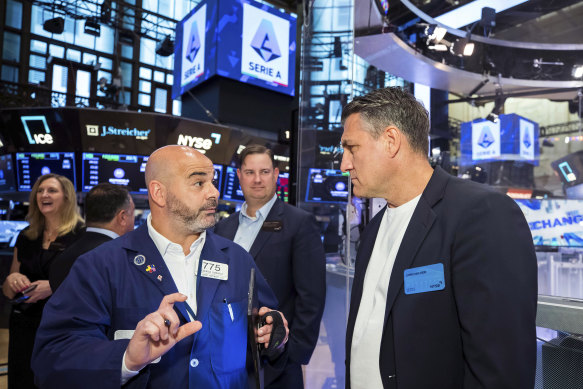ASX edges higher despite inflation, rate hike worries
By Jessica Yun
Welcome to your five-minute recap of the trading day and how experts are seeing it.
The numbers: The Australian sharemarket has moved into positive territory at lunchtime after starting the morning in the red, shaking off Wall Street’s lacklustre performance overnight as investors fretted about higher interest rates and inflation.
The S&P/ASX 200 was up 0.2 per cent or 14.3 points to 7553.3 points at 12:30pm AEDT, buoyed by energy, utilities and banking stocks.

The lifters: Energy players were largely responsible for engineering the turnaround into positive territory, with the sector up 1.2 per cent. Whitehaven Coal, New Hope Corporation and Beach Energy have kept their lead at the top of the pack, up 4.9 per cent, 4.7 per cent and 3.1 per cent respectively.
“Our roads have benefitted from freight volumes which achieved an all-time high, ongoing traffic growth in our core markets,” Charlton said.
Meanwhile, Nuix shares remain in a trading halt. A former chief executive of the tech company has lost a court battle that could have delivered him damages worth almost as much as the controversial tech stock’s current market value.
Overnight on Wall Street, the S&P 500 fell 25.40, or 0.6 per cent, to 4,111.08 for its second straight fall after a stunningly strong report on the U.S. jobs market dented the market’s hopes for easing interest rates. The Dow Jones Industrial Average fell 34.99 points, or 0.1 per cent, to 33,891.02, while the Nasdaq composite dropped 119.50, or 1 per cent, to 11,887.45.
Higher rates slow the economy by design, in hopes of limiting the purchases by households and businesses that can fuel inflation. But they also raise the risk of a severe recession and hurt markets in the meantime.
Friday’s jolting jobs report showed that US employers added a third of a million more jobs than expected last month despite higher rates. Normally, such strength would be good news for markets. At the least, it should mean higher sales for many companies.
But it also raised worries a too-strong labour market will keep inflationary pressures alive and force the Fed to keep rates higher for longer. That’s in direct opposition to hopes in the market that cooling inflation could get the Fed to pause its rate increases soon and then cut rates late this year.
Such hopes had driven a big rally on Wall Street to start the year, and the S&P 500 still remains up more than 7 per cent for 2023 so far. The stocks leading the way had been the ones most beaten down last year by the rattlingly swift rise in rates engineered by the Fed to combat inflation. Those include tech stocks and others seen as the riskiest or most expensive.
Fed Chair Jerome Powell may give some more clues about where rates are heading on Tuesday, when he’s scheduled to speak at the Economic Club of Washington, D.C.
Besides Powell, markets are also waiting to hear from nearly 100 companies in the S&P 500 this week about how much profit they made during the final three months of 2022.
Most Viewed in Business
Source: Thanks smh.com